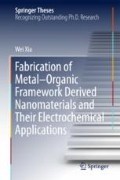Abstract
Metal oxides are promising alternatives to Pt-based electrocatalysts for ORR due to their facile synthesis and high stability under alkaline and oxidative conditions.
Access this chapter
Tax calculation will be finalised at checkout
Purchases are for personal use only
References
Ota K, Ishihara A (2013) Metal oxide-based compounds as electrocatalysts for oxygen reduction reaction. In: Shao M (eds) Electrocatalysis in fuel cells. Lecture notes in energy, vol 9. Springer, London
Liang Y, Li Y, Wang H et al (2011) Co3O4 nanocrystals on graphene as a synergistic catalyst for oxygen reduction reaction. Nat Mater 10:780–786
Liang Y, Li Y, Wang H et al (2013) Strongly coupled inorganic/nanocarbon hybrid materials for advanced electrocatalysis. J Am Chem Soc 135:2013–2036
Xia W, Mahmood A, Liang Z et al (2016) Earth-abundant nanomaterials for oxygen reduction. Angew Chem Int Ed 55:2650–2676
Park KS, Ni Z, Cote AP et al (2006) Exceptional chemical and thermal stability of zeolitic imidazolate frameworks. Proc Natl Acad Sci U S A 103:10186–10191
Xia W, Zou R, An L et al (2015) A metal-organic framework route to in situ encapsulation of Co@Co3O4@C core@bishell nanoparticles into a highly ordered porous carbon matrix for oxygen reduction. Energy Environ Sci 8:568–576
Jun S, Joo S, Ryoo R et al (2000) Synthesis of new, nanoporous carbon with hexagonally ordered mesostructure. J Am Chem Soc 122:10712–10713
Wu G, Mack N, Gao W et al (2012) Nitrogen-doped graphene-rich catalysts derived from heteroatom polymers for oxygen reduction in nonaqueous lithium–O2 battery cathodes. ACS Nano 6:9764–9776
Sharifi T, Hu G, Jia X et al (2012) Formation of active sites for oxygen reduction reactions by transformation of nitrogen functionalities in nitrogen-doped carbon nanotubes. ACS Nano 6:8904–8912
Sheng Z, Shao L, Chen J et al (2011) Catalyst-free synthesis of nitrogen-doped graphene via thermal annealing graphite oxide with melamine and its excellent electrocatalysis. ACS Nano 5:4350–4358
Guo D, Shibuya R, Akiba C et al (2016) Active sites of nitrogen-doped carbon materials for oxygen reduction reaction clarified using model catalysts. Science 351:361–365
Fu L, Liu Z, Liu Y et al (2005) Beaded cobalt oxide nanoparticles along carbon nanotubes: towards more highly integrated electronic devices. Adv Mater 17:217–221
Reichhardt N, Kjellman T, Sakeye M et al (2011) Removal of intrawall pores in sba-15 by selective modification. Chem Mater 23:3400–3403
Gao F, Lu Q, Liu X et al (2001) Controlled synthesis of semiconductor PbS nanocrystals and nanowires inside mesoporous silica SBA-15 phase. Nano Lett 1:743–748
Lastoskie C, Gubbins KE, Quirke N (1993) Pore size heterogeneity and the carbon slit pore: a density functional theory model. Langmuir 9:2693–2702
Vinu A, Hossian K, Srinivasu P et al (2007) Carboxy-mesoporous carbon and its excellent adsorption capability for proteins. J Mater Chem 17:1819–1825
Lee H, Cho W, Oh M (2012) Advanced fabrication of metal–organic frameworks: template-directed formation of polystyrene@ZIF-8 core–shell and hollow ZIF-8 microspheres. Chem Commun 48:221–223
Sorribas S, Zornoza B, Téllez C et al (2012) Ordered mesoporous silica–(ZIF-8) core–shell spheres. Chem Commun 48:9388–9390
Guo S, Zhang S, Wu L et al (2012) Co/CoO nanoparticles assembled on graphene for electrochemical reduction of oxygen. Angew Chem Int Ed 51(47):11770–11773
Zheng Y, Jiao Y, Jaroniec M et al (2012) Nanostructured metal-free electrochemical catalysts for highly efficient oxygen reduction. Small 8(23):3550–3566
Deng D, Yu L, Chen X et al (2013) Iron encapsulated within pod-like carbon nanotubes for oxygen reduction reaction. Angew Chem Int Ed 52:371–375
Kim C, Lee D, Pinnavaia T (2004) Graphitic mesostructured carbon prepared from aromatic precursors. Langmuir 20:5157–5459
Author information
Authors and Affiliations
Rights and permissions
Copyright information
© 2018 Springer Nature Singapore Pte Ltd.
About this chapter
Cite this chapter
Xia, W. (2018). Formation of Core-Shell Metal Oxide Nanoparticles for Oxygen Reduction. In: Fabrication of Metal–Organic Framework Derived Nanomaterials and Their Electrochemical Applications. Springer Theses. Springer, Singapore. https://doi.org/10.1007/978-981-10-6811-9_4
Download citation
DOI: https://doi.org/10.1007/978-981-10-6811-9_4
Published:
Publisher Name: Springer, Singapore
Print ISBN: 978-981-10-6810-2
Online ISBN: 978-981-10-6811-9
eBook Packages: Chemistry and Materials ScienceChemistry and Material Science (R0)

